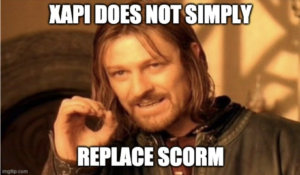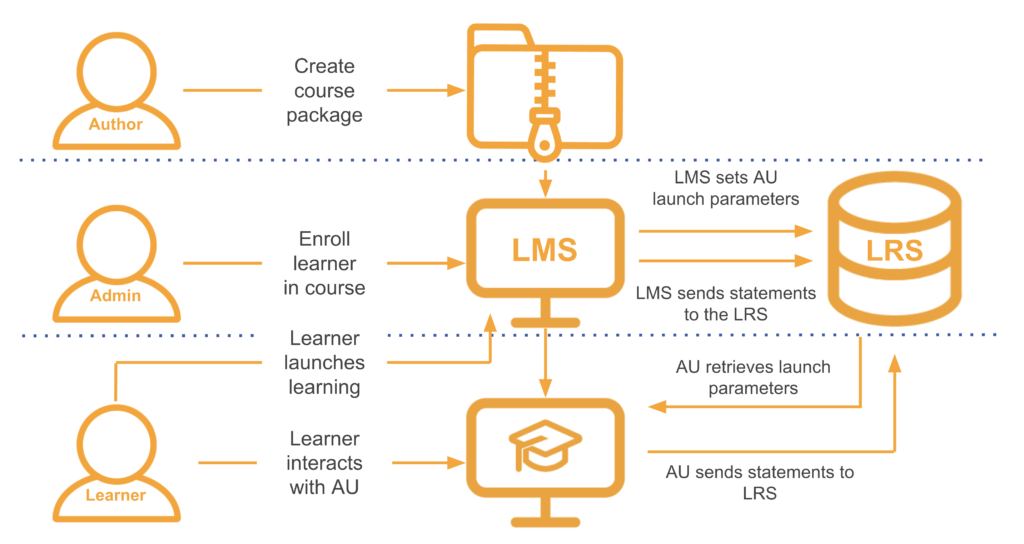Around Rustici, we’re ramping up to launch Project CATAPULT in the coming months (I may or may not have recently set my #slack status as “visions of cmi5 danced in her head”). It’s all too common to hear someone say “cmi5 is the bridge between SCORM and xAPI” around the office. But what does that actually mean in non-technical terms? Glad you asked (if you’d like the technical explanation, we certainly have that here).
What is cmi5 in 1,000 words or less?
Back in the day, SCORM was developed to provide specific guidance for plug and play interoperability of eLearning content across LMSs. Think of it like a DVD (people still watch those, right?). No matter which DVD you buy, it’ll play in your DVD player at home; you don’t need different players to watch different DVDs. But we’ve come a long way since the early days of SCORM in terms of technological advancements.

xAPI came along and was designed to track all kinds of learning activities across different technologies that often sit outside of an LMS, like mobile apps, gaming, simulations, virtual reality and augmented reality. However, LMSs still play an important part of training at many organizations. xAPI, on its own, doesn’t have defined rules for launching a course, vocabulary, content packaging, session management or tracking instructions, which are all vital components to launch and track a course with an LMS.
Behold: cmi5, which provides a way to move from SCORM to the more modern xAPI specification. cmi5 gives you the best of both worlds by having the flexibility of xAPI to track virtually any type of learning activity and the structure of SCORM that learning technologies and systems have historically relied upon. Or, as some like to say, it’s a Reese’s Peanut Butter Cup; you get the chocolate and the peanut butter. Said another way, cmi5 bridges the gap between SCORM and xAPI much like the Bifröst reaches between Midgard (Earth) and Asgard in Norse mythology.
Essentially: cmi5 = LMS + xAPI data
Diving a little deeper, cmi5 is the name – not the acronym – of the xAPI profile that uses a simplified tracking data model by only specifying the essential elements needed to be interoperable across most learning instances. That’s score, status and time. While cmi5 only explicitly defines the necessities for handling xAPI activities in the context of a launching system, it’s capable of recording and reporting or retrieving content-defined data, which means content authors and designers are able to add features without sacrificing plug and play interoperability.
But why should someone use this new fangled standard? With new being relative as cmi5 was first developed in 2010. If you need a refresher on what was cool in 2010, “Harry Potter and the Deathly Hollows Part 1” was released and “Moves Like Jagger” became a hit.
After a few iterations, cmi5 was modified to be the bridge between SCORM and xAPI in 2016.
A few reasons why you’ll want to consider creating or buying cmi5 courseware:
- cmi5 is not dependent on a browser to communicate or launch courses, content or experiences.
- If you want to incorporate newer technologies and distributed learning resources into your training but still use your LMS for learners to access.
- When you want the advanced tracking capabilities that xAPI provides.
How does cmi5 work?
Time to cross the Bifröst into the Technical-gard realm.
cmi5 has four main elements that are important to know:
- Assignable Units (AUs) – each learning activity
- Course Package – course structure that defines AUs and their metadata
- Learning Management System (LMS)
- Learning Record Store (LRS) – receives, stores and retrieves xAPI statements.
The content author creates AUs (learning activities) that use xAPI to capture advanced learner data and assembles the AUs into a course structure with instructions. The content author also provides satisfaction rules. The AU’s resources may be referenced via an XML file from an external host or saved in a ZIP file along with the course structure.
The learner initiates (starts) the launch of an AU, and the LMS prepares launch data and records the launch in the LRS. The LMS then redirects the learner to the AU presentation, and the learner interacts with the AU.
The AU records activities, scores, mastery and completion to the LRS and then continues on to additional AUs.
Conceptual overview of cmi5

Source: ADL cmi5 Specification
Why hasn’t everyone embraced cmi5 like they have Loki?
Now that we know that cmi5 is basically the Bifröst, why hasn’t everyone embraced its glorious purpose?
There haven’t been tools and guidance for the specification to help drive adoption by vendors. Seeing this need, the Advanced Distributed Learning (ADL) Initiative contracted Rustici Software to build conformance tools. Project CATAPULT, a (somewhat) clever acronym that stands for cmi5 Advanced Testing Application and Player Underpinning Learning Technologies.
The Rustici Project CATAPULT team is currently busy magically constructing these helpful tools:
- Content Conformance Test Suite for content creators and instructional designers to test courses.
- Systems Conformance Test Suite to test LMS conformance.
- Open source Player Prototype that functions as a cmi5 content player.
- cmi5 Course templates to use as guides for converting legacy courses. These are like the sample SCORM golf courses, except that they rock.
- Best practices guide, which will be “the” book on cmi5.
If you’re interested in creating or acquiring cmi5 content, now’s the time to ask your LMS, authoring tool vendors and content vendors if they support cmi5 or if it’s on their roadmap. The more people who are interested in cmi5, the more likely it is that tools and systems will start adding cmi5 support.
Ready for more cmi5?
Have more questions about cmi5? Ask us! We’re happy to help with all of your cmi5 questions.
Here are a few more resources to help you learn more:
- Learn more about cmi5.
- Find the cmi5 CATAPULT assets.
- Subscribe to the xAPI blog for the latest on Project CATAPULT.
- Visit ADL’s Project CATAPULT page, cmi5 page and cmi5 resources page for more background and information.
- Join the cmi5 weekly working group.


